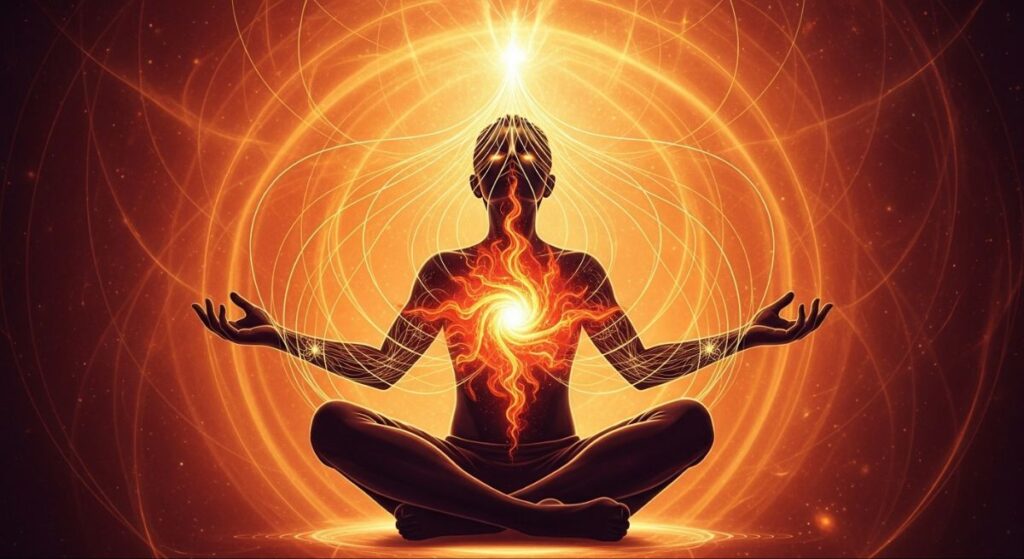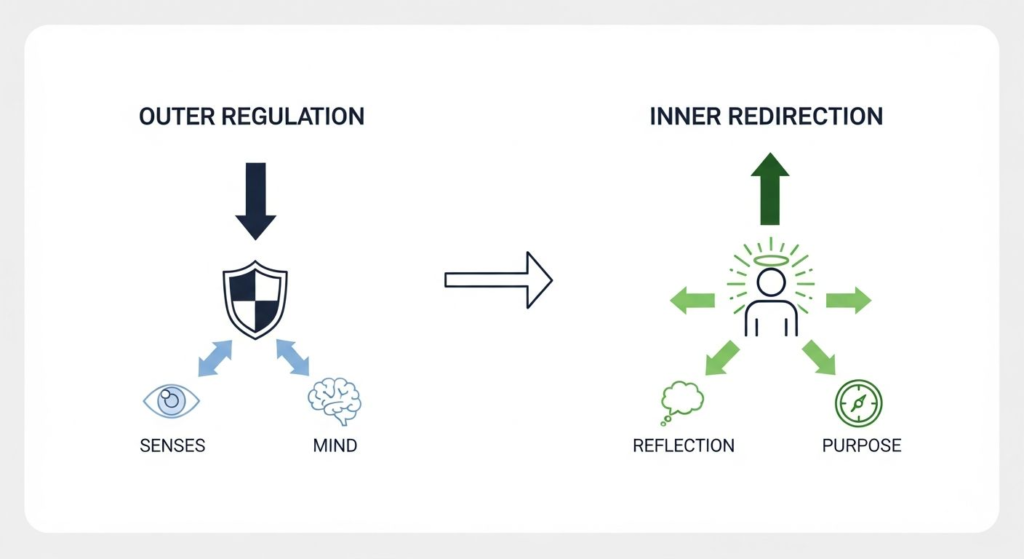Ancient Spiritual Technologies for Self-Mastery: Yoga & Gita Blueprint
The path out of compulsion is provided by the ancient philosophical technologies of Yoga and Vedanta. These practices offer a rigorous and reliable blueprint for regaining mastery over the mind and senses.
The Foundational Spiritual Technology of Self-Mastery
The ancient philosophical systems of Yoga and Vedanta provide a clear pathway for breaking free from compulsive behaviors. These time-tested practices offer a structured blueprint for strengthening the mind, directing the senses, and restoring inner control.
A. Pillar 1: Pratyahara (The Withdrawal of Senses)
Today’s digital world has created a massive crisis of sensory overload. Algorithms, notifications, and constant stimulation keep the mind restless. The ancient antidote to this condition is Pratyahara, the fifth limb of Patanjali’s Yoga Sutras, which means withdrawal of the senses. It is designed to counter the noise and mental agitation (citta) created by continuous sensory input (citta vrtti nirodhah).Pratyahara teaches how the mind and senses are closely linked. Classical wisdom compares this connection to “bees following their queen” where the mind moves, the senses follow. In ordinary waking life, the senses run outward toward objects, and the mind instinctively follows them.
The practice of Pratyahara reverses this habit. By training the mind to stay fixed on an inner point of attention, the senses gradually stop seeking external stimulation. For individuals struggling with screen addiction, the most practical step involves stabilizing the gaze simply fixing the eyes on a single point. As the gaze steadies, the mind also begins to quieten. This marks the beginning of inner stillness, preparing the practitioner for deeper meditation and emotional detachment.

B. Pillar 2: Brahmacharya and Tapas (Energy and Discipline)
Addictive behaviors fueled by desire and misdirected energy are addressed through the twin principles of Brahmacharya and Tapas. Although commonly misunderstood as strict celibacy, Brahmacharya is much broader. It refers to disciplined use of energy and mastery over the senses so that one can pursue higher self-realization. It involves channeling pranavital life energy away from momentary indulgence and toward spiritual clarity (ojas). Addiction is therefore reframed not as moral weakness but as a challenge of managing one’s energy wisely.
This shift requires Tapas, or disciplined self-restraint. Tapas strengthens willpower (Sankalpa) and burns away the impurities associated with Rajasic and Tamasic tendencies of the mind. With consistent discipline, self-control becomes a natural part of one’s character, supporting long-term growth and success.

C. Pillar 3: Karma Yoga (Detachment from Outcome)
Modern addictions thrive because people become attached to outcomesscores, likes, instant purchases, and quick pleasure.This craving for the “fruit of action’’ is addressed directly in Karma Yoga, as explained in the Bhagavad Gita Lord Krishna teaches: “You have a right to perform your duty, but not to the fruits of your actions. Do not consider yourself the doer of results, and do not be attached to inaction.”
Detachment (Vairagya) is not apathy. It is a pathway to “inner freedom and lasting peace.”By shifting focus to the sincerity and quality of one’s actions rather than what one gains from them the compulsive loop weakens. Karma Yoga encourages offering every action to the Divine, converting ordinary tasks into spiritual practice. This transforms the motivation from selfish consumption to selfless service, freeing the mind from entanglement.

D. The Two-Pronged Strategy: Krishna’s Blueprint
The scriptures recommend a dual strategy to overcome deep-rooted desire (Kama). This approach addresses both the external environment and the internal state of consciousness.
The Bhagavad Gita’s Two-Pronged Strategy for Combating Compulsion (Kama)
| Strategy Prong | Gita Concept | Application to Modern Addiction | Goal |
| 1.Outer Regulation | Distance from Sense Objects (Sensory Shield) | Structuring the physical environment limiting access,removing triggers, setting boundaries. | Avoid impulsive indulgence and reduce temptation by creating safe distance. |
| 2.Inner Redirection | Situating in Spiritual Identity (Buddhi) | Using higher intelligence to redirect desires toward spiritual fulfillment, devotion, and disciplined practice. | Transform material craving into spiritual love and non-material joy. |
Outer regulation provides protection by limiting unnecessary temptation. Inner redirection, guided by Buddhi (higher intelligence), helps one consciously channel energy toward meaningful, lasting fulfillment.

(FAQ: Self-Mastery & Yoga Concepts)
1. What is Pratyahara in Yoga?
Pratyahara is the fifth limb of Yoga and refers to the withdrawal of the senses from external distractions.
It helps calm the mind and reduce compulsive behaviors created by constant sensory overload.
2. How does Brahmacharya help in self-mastery?
Brahmacharya promotes disciplined use of energy. Instead of wasting vital energy on temporary indulgence,
it directs it toward clarity, focus, and personal growth.
3. What is the role of Tapas in overcoming addiction?
Tapas means self-discipline and austerity. It strengthens willpower and burns away negative tendencies, helping
individuals develop consistent self-control.
4. Why is Karma Yoga important for breaking habits?
Karma Yoga teaches detachment from outcomes. By focusing on sincere and selfless action instead of rewards, cravings, or quick results, the mind becomes calmer and more stable.
5. How does the Bhagavad Gita help with modern addictions?
The Gita presents a dual approach:
- Outer Regulation: reducing exposure to temptations,
- Inner Redirection: guiding desires toward higher spiritual fulfillment.
This combination helps reduce compulsive behavior.
6. What is the spiritual solution to compulsive behavior?
Yoga and Vedanta teachings recommend controlling the senses, managing energy wisely, practicing discipline, and acting
without attachment. These methods collectively support deep inner transformation.
Final My Conclusion:
In the end, bro, everything comes down to one simple truth: the mind listens only when we learn to sit with ourselves. These ancient teachings aren’t theories they’re practical tools that help us slow down, breathe, and take back control of our lives.
Pratyahara teaches us to step away from noise.
Brahmacharya and Tapas show us how to use our energy wisely.
Karma Yoga reminds us to do our best without stressing about results.
When these pieces come together, something beautiful happens:
you stop fighting with your mind… and start guiding it.
Self-mastery isn’t about perfection.
It’s about showing up every day with a little more awareness, a little more discipline, and a little more intention.
If you take even one of these practices seriously, bro, you will feel the shift.
Slowly, your habits change… your focus sharpens… and you begin to realise that the real strength has always been inside you.
This is the journey. This is the work. And this is how you rise.
Read This Article Also:
The Crisis of the Uncontrolled Mind: Dharma vs Modern Addiction


